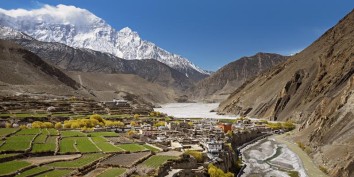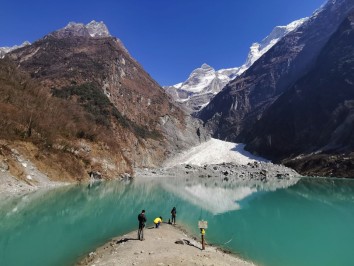Annapurna Circuit Trek - 10 Days

Annapurna Circuit Trek - 10 Days Overview
The Annapurna Circuit Trek in Nepal is a classic route that offers stunning mountain views, diverse landscapes, and cultural experiences. It spans 160–230 km. Highlights include the challenging Thorong La Pass at 5,416 meters.
The Annapurna Base Camp trek is more than just a mountain hike; a journey through time, culture, emotion, and self-discovery. Every step you take brings you closer to something bigger than yourself in this place, where snow whispers ancient mysteries flutter in the thin air. Compared to other treks in the Annapurna region, the 10-day Annapurna Base Camp Trek allows you to see all of the main sights of the massive Himalayan ranges in a shorter amount of time. It transports you to the breathtakingly high snow-capped peaks, the distinctive Gurung villages and culture, and breathtaking scenery. It is also well-known for its chocolate box valleys and steep slopes. Nowadays, a lot of hikers come here to explore the routes. Above all, the Annapurna trekking route is full of interesting cultural, heritage, and natural beauty. It has suddenly become one of the most popular trekking trails with numerous eager hikers.
At 8091 meters, it is also the location of Mt. Annapurna, the tenth-highest mountain in the world. The breathtaking scenery of the Himalayas makes your heart skip a beat. The welcoming and warm hospitality of the various tribes' residents keeps you content. For those from all over the world, we have planned a 10-day Annapurna Base Camp Trek that begins in Kathmandu, travels to Pokhara, and continues to Nayapul (1,050m), where we start our journey with the Modi Khola River. We will arrive at Chhomrong (2,170m) the following day, after which we will go to the Himalaya Lodge at Ghandruk (1,940m). You will be treated to breathtaking views of snow-capped mountains throughout the trek. The following day, we hike to the Himalaya Lodge at Ghandruk (1,940m). Along the trail, you will see marvelous views of snowy mountains. The next day, we follow the trail to the Himalaya Lodge at Himalaya, where you will have time to explore this mountainous, local town and admire their Gurung culture.
Highlights of Annapurna Circuit Trek
- Standing at the base of the world's 10th highest peak, Annapurna, surrounded by towering mountains.
- Incredible views of the sacred Machhapuchhre mountain, known for its unique fishtail shape.
- Relaxing in natural hot springs, perfect for unwinding after a day of trekking.
- Exploring a traditional Gurung village with rich culture, a local museum, and lovely surroundings.
- Watching the sunrise light up Mt. Dhaulagiri, Mt. Annapurna, and Mt. Machhapuchhre.
- Walking through beautiful rhododendron, oak, and pine forests, and scenic terraced fields.
- Captivating views of Pokhara and Phewa Lake from the ridge at Deorali.
- Discovering charming villages along the way, perched on ridge tops and surrounded by terraced fields.
- Transitioning from dense forests to alpine scrub as you get closer to the Annapurna Sanctuary.
- Enjoying the natural beauty of waterfalls and glaciers along the trek.
Best Season for Trekking in Annapurna Base Camp
Choosing the right season for your Annapurna Base Camp Trek can make a significant difference in your overall experience. At Nepal Horizon Treks, we want to ensure you have the most enjoyable and memorable adventure, and understanding the best times to trek is crucial.
Spring (March to May):
Spring is one of the most popular seasons for trekking to Annapurna Base Camp. During this time, the weather is mild, and the skies are usually clear, offering excellent views of the mountains. The trails come alive with blooming rhododendrons and a variety of other flowers, creating a colorful and vibrant atmosphere. This is also a great time to spot wildlife and enjoy the fresh, crisp air.
Autumn (September to November):
Autumn is another ideal season for trekking in the Annapurna region. After the monsoon rains, the skies are clear, and the air is fresh, providing the best visibility for the breathtaking mountain views. The temperatures are comfortable, making the trek more enjoyable. This season also coincides with major Nepalese festivals like Dashain and Tihar, allowing you to experience the rich cultural traditions of the local communities along the way.
Both these seasons offer unique advantages and ensure a more pleasant trekking experience with stable weather conditions and less likelihood of rain. Whether you choose the blossoming beauty of spring or the clear, crisp days of autumn, trekking with Nepal Horizon Treks during these times will provide you with unforgettable memories and the best that nature has to offer.
Why choose Nepal Horizon Trek?
We are not just a trekking operator, we are the storytellers of these Himalayas, guardians of the trails, proud locals of these mountains, and keepers of this local wisdom.
- We have expert local guides with years of experience, high-altitude training, and deep cultural knowledge.
- We provide personalized care that includes small groups, daily health checks, and altitude-aware pacing.
- We have proper Cultural immersion services like learning about Gurung customs, attending Buddhist rituals, and sharing tea with locals.
- We prioritize safety above all, so we provide you with proper service equipped with first-aid kits, oxygen, and emergency contacts.
- We provide sustainable & responsible trekking services where we tread lightly, support local communities, and advocate for environmental respect.
- We have over 10 years of experience with every trail etched into our memory.
- We trek with care and respect local culture, supporting communities, and leaving no trace.
- For us, you’re not a client, you’re family, and together we create memories with warmth, laughter, and lifelong bonds.
How to get prepared for the Annapurna Base Camp trek?
Preparing for the Annapurna Base Camp (ABC) trek is also the key to enjoying the experience safely and comfortably. Here’s a complete guide to know how to get prepared before the Annapurna Base Camp trek.
Physical Preparation
-
You should start training 4–6 weeks before your trek.
- You should do cardio exercises like hiking, jogging, swimming, or cycling
- It also includes leg strength training (squats, lunges, stair climbing).
- You should add practicing hikes with a backpack to simulate real conditions.
Endurance & Altitude Readiness
- You can also go long walks (6–7 hours) to build stamina.
- If possible, you can do high-altitude hikes before ABC to test yourself.
Packings
- Clothes and necessary items that you should pack are:
- Fleece or down jacket (warm layer)
- Waterproof/windproof outer shell (jacket & pants)
- Trekking pants & thermal underwear
- Gloves, hat, buff/neck gaiter
- Quickly drying t-shirts and underwear
- Warm socks (multiple pairs)
- Comfortable trekking boots
- Sleeping bag (rated for -10°C or lower)
- Trekking poles
- Headlamp with extra batteries
- Sunglasses & sunscreen
- Water bottles (and purification tablets/filter)
Toiletries & Medicine
- Toilet paper, wet wipes, and hand sanitizer
- Basic first aid kit
- Altitude sickness medicine
- Painkillers, band-aids, ORS
Permits and Documents Required
- TIMS card (Trekker’s Information Management System)
- ACAP permit (Annapurna Conservation Area Project)
Annapurna Base Camp Circuit Trek 10 Days Map overview
|
Day |
Route |
Altitude |
Duration |
Notes |
|
Day 1 |
Kathmandu → Dharapani |
1,960 m |
7–10 hours (Drive) |
Long drive via Besisahar |
|
Day 2 |
Dharapani → Chame |
2,710 m / 8,890 ft |
6–7 hours (Trek) |
Scenic trails with views of Lamjung Himal |
|
Day 3 |
Chame → Pisang |
3,115 m / 10,200 ft |
5–6 hours (Trek) |
The trail passes through pine forests |
|
Day 4 |
Pisang → Manang |
3,540 m / 11,300 ft |
8–9 hours (Trek) |
Acclimatization zone |
|
Day 5 |
Rest Day in Manang |
3,540 m / 11,300 ft |
- |
Acclimatization hike optional |
|
Day 6 |
Manang → Ledar |
4,200 m / 14,206 ft |
4–5 hours (Trek) |
Gradual ascent, watch for altitude signs |
|
Day 7 |
Ledar → Thorong Phedi / High Camp |
4,900 m / 15,091 ft |
3–4 hours (Trek) |
Steep and rocky terrain |
|
Day 8 |
Thorong Phedi → Muktinath (via Thorong La) |
Pass: 5,416 m / 17,764 ft |
7–9 hours (Trek) |
Long, challenging day with steep descent |
|
Day 9 |
Muktinath → Jomsom / Ghasa / Marpha |
~2,700 m (varies by stop) |
~4 hours (Trek) |
Choice of route and stop |
|
Day 10 |
Ghasa → Pokhara |
850 m / 2,788 ft |
6–7 hours (Drive) |
Relaxing drive back |
10-day Annapurna Circuit trek itinerary outline
Day 1: Drive from Kathmandu to Dharapani (1,960m) Duration: 7- 10 hours
Day 2: Trek from Dharapani to Chame (2,710 m/8,890 ft) Duration: 6-7 hours.
Day 3 Trek to Pisang (3,115 m/10,200 ft) Duration: 5-6 hours.
Day 4: Trek to Manang (3540 m/11,300ft) Duration: 8-9 hours.
Day 5: Rest in Manang for acclimatization
Day 6: Trek to Ledar (4200m/14206ft) Duration: 4-5 hours.
Day 7 Trek to Thorong Phedi or High Camp (4900 m/15091 ft) Duration: 3-4 hours.
Day 8: Trek to Muktinath (3,800m/12467 ft) Via Thorong La pass (5,416m/17764 m) Duration: 7-9 hours.
Day 9: trek to Jomsom, Ghasa, or Marpha, 4 hours
Day 10: Drive from Ghasa to Pokhara (850m/2788 ft) Duration: 6-7 hours.
Annapurna Circuit Trek - 10 Days Itinerary
A full-day jeep ride carries you west along the Prithvi Highway, then north up the Marsyangdi Valley past rice terraces and waterfalls. The road turns rough after Besisahar, finishing in the quiet village of Dharapani—your gateway to the Annapurna Circuit.
 MEALS
MEALS
 Breakfast, dinner, Lunch
Breakfast, dinner, Lunch
You hike beside the thunderous Marsyangdi River, weaving through pine, fir, and oak forests. Timang and Koto offer the first big views of Lamjung Himal and Annapurna II before you reach the district hub of Chame, warmed by natural hot springs.
 MEALS
MEALS
 Breakfast, dinner, Lunch
Breakfast, dinner, Lunch
The valley narrows into a dramatic rock gorge called Paungda Danda, its sheer wall rising 1,500 m above the trail. Crossing a series of prayer-flagged bridges, you arrive at Lower or Upper Pisang, ringed by juniper forests and snowy peaks.
 MEALS
MEALS
 Breakfast, dinner, Lunch
Breakfast, dinner, Lunch
Following the higher trail through Ghyaru and Ngawal rewards you with 360-degree panoramas of the Annapurna massif. A final gentle traverse delivers you to the arid, Tibetan-influenced town of Manang, where yaks graze beneath ice-clad Gangapurna.
 MEALS
MEALS
 Breakfast, dinner, Lunch
Breakfast, dinner, Lunch
A “rest” day that usually means a side hike—perhaps to the Gangapurna Glacier viewpoint or the cliff-top monastery at Braga—to boost red-blood-cell production while you soak in alpine scenery.
 MEALS
MEALS
 Breakfast, dinner, Lunch
Breakfast, dinner, Lunch
Leaving trees behind, you climb steadily through yak pastures and windswept hills to Yak Kharka and onward to Ledar. Thin air and crisp skies signal your entry into the high Himalaya.
 MEALS
MEALS
 Breakfast, dinner, Lunch
Breakfast, dinner, Lunch
A short but steep ascent over landslide-prone slopes leads to the stone shelters of Thorong Phedi. Many continue another 400 m to High Camp to shorten the next day’s climb.
 MEALS
MEALS
 Breakfast, dinner, Lunch
Breakfast, dinner, Lunch
Pre-dawn, you zigzag up scree and snow to the prayer-flag-draped Thorong La, the trek’s high point. The reward is a sunrise panorama from Dhaulagiri to Manaslu before a knee-testing 1,600-m descent to the sacred temple complex of Muktinath.
 MEALS
MEALS
 Breakfast, dinner, Lunch
Breakfast, dinner, Lunch
Dropping into the rain-shadowed Mustang Valley, you stride through medieval Kagbeni or apple-orchard-lined Marpha, eventually reaching the windy airstrip town of Jomsom—or farther downhill to green Ghasa—for a change of scenery and altitude.
 MEALS
MEALS
 Breakfast, dinner, Lunch
Breakfast, dinner, Lunch
You trade boots for a jeep, rattling down the Kali Gandaki Gorge—the world’s deepest—then rolling onto smooth highway. Lush hills and Lake Phewa welcome you back to the subtropics and the laid-back lakeside city of Pokhara, where hot showers and celebratory momos await.
 MEALS
MEALS
 Breakfast, dinner, Lunch
Breakfast, dinner, Lunch
Cost Includes/Excludes
What are Included In My Package ?
- Teahouse accommodations and meals (breakfast, Lunch, & Dinner) during the trek
- All the ground transportation as per the itinerary in local vehicles abd local bus, and jeep
- An experienced, English-speaking, and government-licensed trekking guide
- A Porter service (2 trekkers: 1 porter)
- All the trekking staff's salary, insurance, equipment, domestic airfare, food, and accommodation
- Down jacket and Sleeping Bag (to be returned after the completion of the trip)
- All the necessary trekking permits and paperwork
- Kathmandu to Besishahar by local bus and local jeep to Dharapani
- Ghasa or Marpha to Pokhara by local bus, sharing transport
- All the governmental and local taxes
- Medial kit (carried by your trek leader)
- Service charge office
What are excluded from the package ?
- Lunch and dinner in Kathmandu and Pokhara
- Travel and rescue insurance
- Personal nature expenses – Phone calls, laundry, bar bills, battery recharge, extra porters, bottle or boiled water, shower, etc.)
- Tips for guides, porters
FAQs
The Annapurna Circuit Trek is considered moderately to highly difficult, depending on your fitness level and experience. It covers 160–230 km (100–145 miles) and involves daily hikes of 5–7 hours, with steep ascents and descents, high-altitude challenges—especially crossing the Thorong La Pass at 5,416 meters—and varying weather conditions. While no technical climbing is required, good physical conditioning, proper acclimatization, and mental endurance are essential for a safe and enjoyable experience.
As of April 2023, solo trekking on the Annapurna Circuit is no longer permitted without a licensed guide, due to safety concerns and new government regulations in Nepal. While it was previously possible to do the trek independently, hiring a registered guide through a trekking company is now mandatory to ensure your safety, support local employment, and help in emergencies.
Yes, the Annapurna Circuit Trek can be done in 10 days, but it requires a shortened itinerary and good physical fitness. Many trekkers now choose a condensed version by starting from Chame and ending in Jomsom or flying out from there, skipping the lower-altitude sections. While it's possible, proper acclimatization is still crucial—especially before crossing Thorong La Pass—so careful planning and flexibility are key to doing it safely in a shorter timeframe.
Yes, beginners can do the Annapurna Circuit Trek, but it requires good preparation, physical fitness, and mental determination. While the trail doesn't involve technical climbing, the long distances, high altitudes—especially at Thorong La Pass (5,416m)—and changing weather can be challenging. With proper acclimatization, a well-planned itinerary, and the support of an experienced guide or trekking company, many first-time trekkers successfully complete the trek and find it incredibly rewarding.
Completing the Annapurna Circuit Trek in just 7 days is extremely challenging and only feasible if you take a very short, modified route—typically starting from Chame and ending at Jomsom, with transport before and after to save time. Even then, crossing the high Thorong La Pass (5,416m) in such a short time increases the risk of altitude sickness due to insufficient acclimatization. It’s not recommended unless you're highly fit, experienced at high altitude, and under the guidance of a professional trekking company.
Traveller Useful Information
As you stand on the edge of adventure, remember—this isn’t just a trek, it’s a journey that will awaken your spirit. The Annapurna Circuit is more than just mountains and trails; it's a life-changing path through culture, challenge, and stunning beauty. With Nepal Horizon Treks, you're not just a traveler—you’re family. We’ll walk every step with you, ensuring your safety, comfort, and unforgettable memories.
So lace up your boots, trust your heartbeat, and come discover what lies beyond the next bend in the trail. The Himalayas are calling—and we’re ready to guide you there.#Nepal#NepalHorizonTreks








.jpg)



























